Essay on Economic and Military Conditions of Japan Before World War II
VerifiedAdded on 2022/08/13
|5
|1106
|14
Essay
AI Summary
This essay delves into the economic and military conditions of Japan prior to World War II, examining the interplay of political, economic, and technological factors. It highlights the impact of the Great Depression and Japan's own economic struggles, including the Showa financial crisis. The essay explores how the Emperor-based ideology and the adoption of Buddhism fostered patriotism and military strength, contributing to territorial expansion. Economic decisions, such as banking sector reforms and strategic investments, are analyzed for their role in financial development. Furthermore, the essay discusses technological advancements, particularly in naval construction, and their contribution to Japan's economic and military capabilities. The conclusion emphasizes the significance of Meiji's policies, financial reforms, and technological adaptation in shaping Japan's pre-war power.
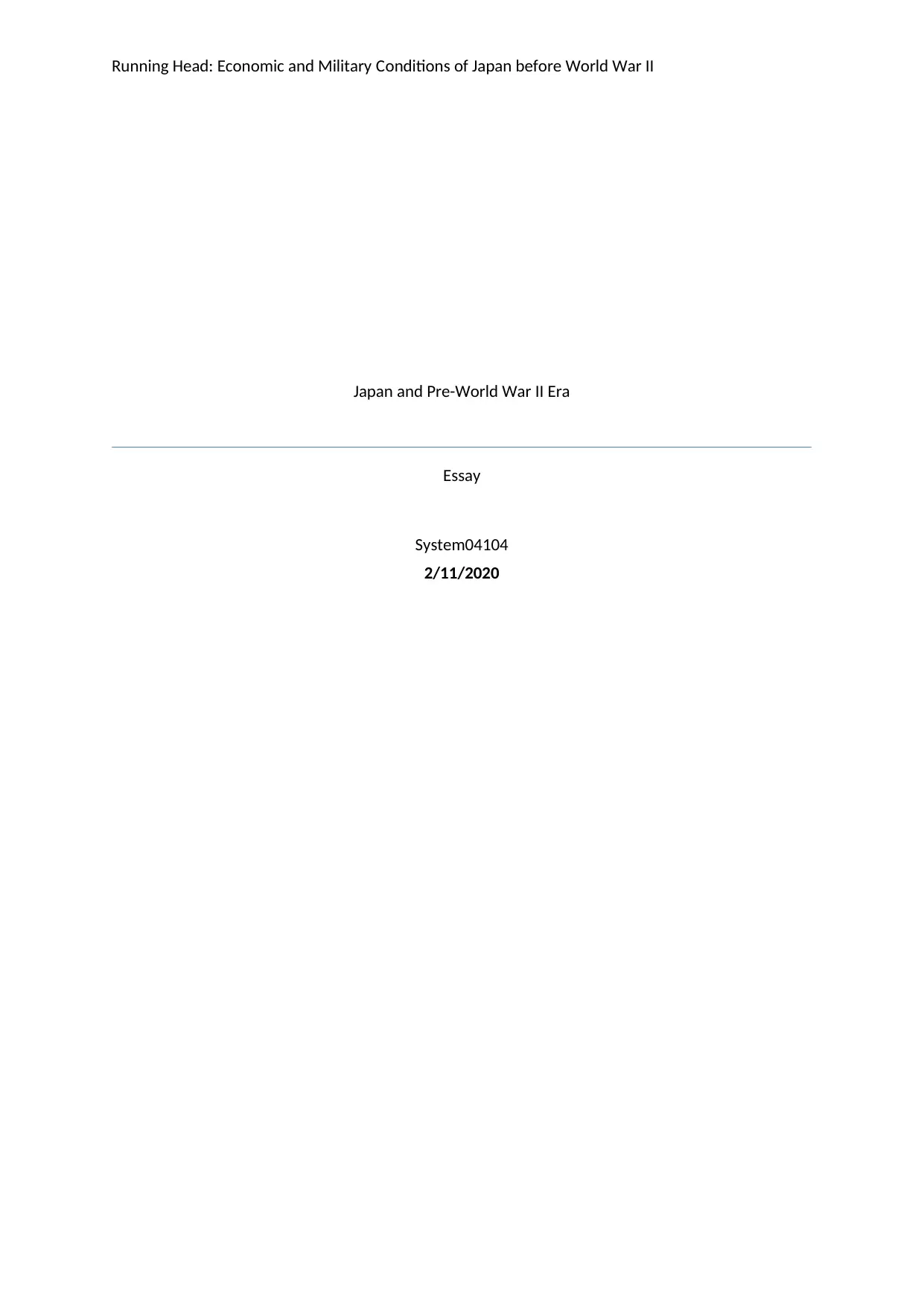
Running Head: Economic and Military Conditions of Japan before World War II
Japan and Pre-World War II Era
Essay
System04104
2/11/2020
Japan and Pre-World War II Era
Essay
System04104
2/11/2020
Paraphrase This Document
Need a fresh take? Get an instant paraphrase of this document with our AI Paraphraser
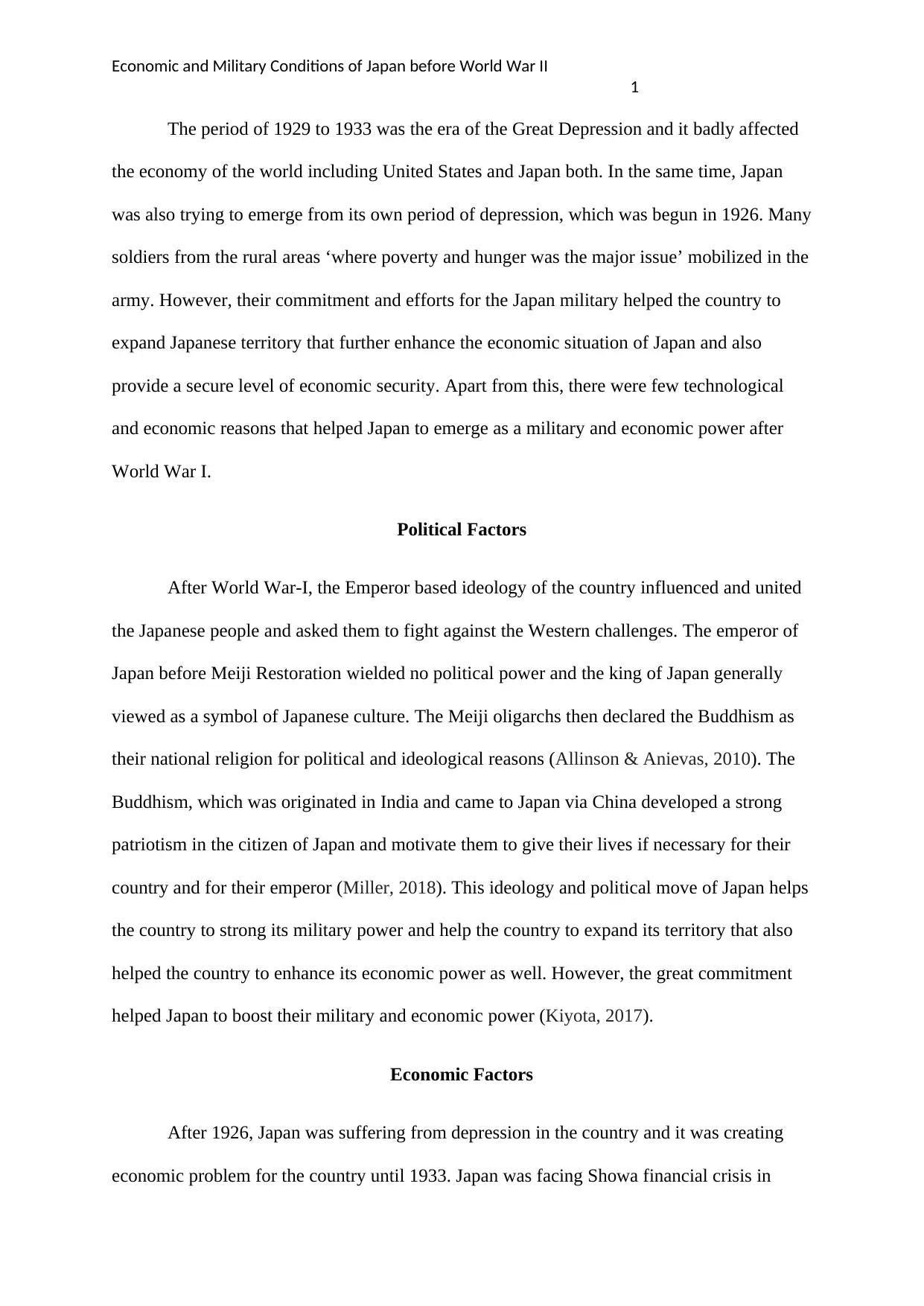
Economic and Military Conditions of Japan before World War II
1
The period of 1929 to 1933 was the era of the Great Depression and it badly affected
the economy of the world including United States and Japan both. In the same time, Japan
was also trying to emerge from its own period of depression, which was begun in 1926. Many
soldiers from the rural areas ‘where poverty and hunger was the major issue’ mobilized in the
army. However, their commitment and efforts for the Japan military helped the country to
expand Japanese territory that further enhance the economic situation of Japan and also
provide a secure level of economic security. Apart from this, there were few technological
and economic reasons that helped Japan to emerge as a military and economic power after
World War I.
Political Factors
After World War-I, the Emperor based ideology of the country influenced and united
the Japanese people and asked them to fight against the Western challenges. The emperor of
Japan before Meiji Restoration wielded no political power and the king of Japan generally
viewed as a symbol of Japanese culture. The Meiji oligarchs then declared the Buddhism as
their national religion for political and ideological reasons (Allinson & Anievas, 2010). The
Buddhism, which was originated in India and came to Japan via China developed a strong
patriotism in the citizen of Japan and motivate them to give their lives if necessary for their
country and for their emperor (Miller, 2018). This ideology and political move of Japan helps
the country to strong its military power and help the country to expand its territory that also
helped the country to enhance its economic power as well. However, the great commitment
helped Japan to boost their military and economic power (Kiyota, 2017).
Economic Factors
After 1926, Japan was suffering from depression in the country and it was creating
economic problem for the country until 1933. Japan was facing Showa financial crisis in
1
The period of 1929 to 1933 was the era of the Great Depression and it badly affected
the economy of the world including United States and Japan both. In the same time, Japan
was also trying to emerge from its own period of depression, which was begun in 1926. Many
soldiers from the rural areas ‘where poverty and hunger was the major issue’ mobilized in the
army. However, their commitment and efforts for the Japan military helped the country to
expand Japanese territory that further enhance the economic situation of Japan and also
provide a secure level of economic security. Apart from this, there were few technological
and economic reasons that helped Japan to emerge as a military and economic power after
World War I.
Political Factors
After World War-I, the Emperor based ideology of the country influenced and united
the Japanese people and asked them to fight against the Western challenges. The emperor of
Japan before Meiji Restoration wielded no political power and the king of Japan generally
viewed as a symbol of Japanese culture. The Meiji oligarchs then declared the Buddhism as
their national religion for political and ideological reasons (Allinson & Anievas, 2010). The
Buddhism, which was originated in India and came to Japan via China developed a strong
patriotism in the citizen of Japan and motivate them to give their lives if necessary for their
country and for their emperor (Miller, 2018). This ideology and political move of Japan helps
the country to strong its military power and help the country to expand its territory that also
helped the country to enhance its economic power as well. However, the great commitment
helped Japan to boost their military and economic power (Kiyota, 2017).
Economic Factors
After 1926, Japan was suffering from depression in the country and it was creating
economic problem for the country until 1933. Japan was facing Showa financial crisis in
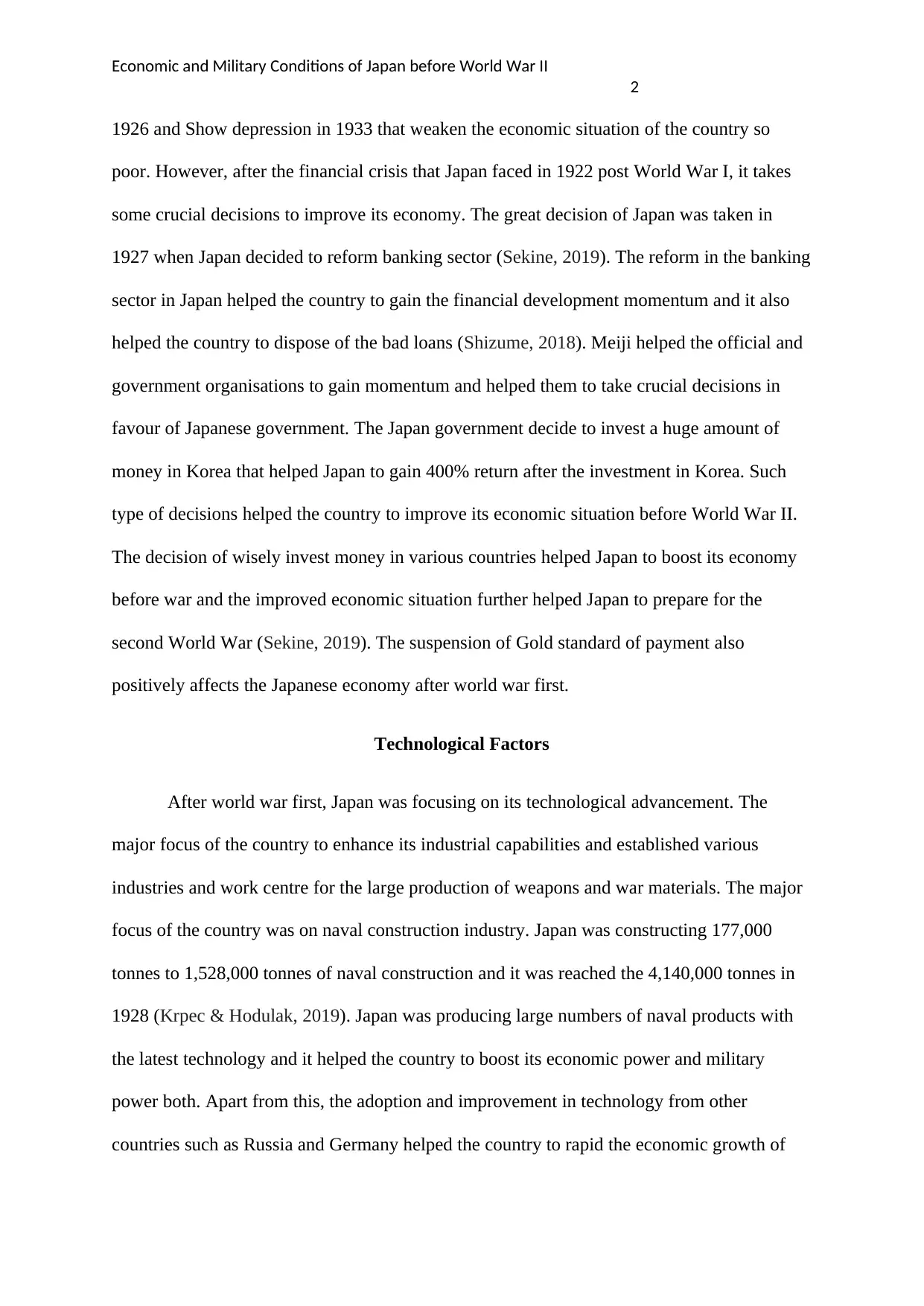
Economic and Military Conditions of Japan before World War II
2
1926 and Show depression in 1933 that weaken the economic situation of the country so
poor. However, after the financial crisis that Japan faced in 1922 post World War I, it takes
some crucial decisions to improve its economy. The great decision of Japan was taken in
1927 when Japan decided to reform banking sector (Sekine, 2019). The reform in the banking
sector in Japan helped the country to gain the financial development momentum and it also
helped the country to dispose of the bad loans (Shizume, 2018). Meiji helped the official and
government organisations to gain momentum and helped them to take crucial decisions in
favour of Japanese government. The Japan government decide to invest a huge amount of
money in Korea that helped Japan to gain 400% return after the investment in Korea. Such
type of decisions helped the country to improve its economic situation before World War II.
The decision of wisely invest money in various countries helped Japan to boost its economy
before war and the improved economic situation further helped Japan to prepare for the
second World War (Sekine, 2019). The suspension of Gold standard of payment also
positively affects the Japanese economy after world war first.
Technological Factors
After world war first, Japan was focusing on its technological advancement. The
major focus of the country to enhance its industrial capabilities and established various
industries and work centre for the large production of weapons and war materials. The major
focus of the country was on naval construction industry. Japan was constructing 177,000
tonnes to 1,528,000 tonnes of naval construction and it was reached the 4,140,000 tonnes in
1928 (Krpec & Hodulak, 2019). Japan was producing large numbers of naval products with
the latest technology and it helped the country to boost its economic power and military
power both. Apart from this, the adoption and improvement in technology from other
countries such as Russia and Germany helped the country to rapid the economic growth of
2
1926 and Show depression in 1933 that weaken the economic situation of the country so
poor. However, after the financial crisis that Japan faced in 1922 post World War I, it takes
some crucial decisions to improve its economy. The great decision of Japan was taken in
1927 when Japan decided to reform banking sector (Sekine, 2019). The reform in the banking
sector in Japan helped the country to gain the financial development momentum and it also
helped the country to dispose of the bad loans (Shizume, 2018). Meiji helped the official and
government organisations to gain momentum and helped them to take crucial decisions in
favour of Japanese government. The Japan government decide to invest a huge amount of
money in Korea that helped Japan to gain 400% return after the investment in Korea. Such
type of decisions helped the country to improve its economic situation before World War II.
The decision of wisely invest money in various countries helped Japan to boost its economy
before war and the improved economic situation further helped Japan to prepare for the
second World War (Sekine, 2019). The suspension of Gold standard of payment also
positively affects the Japanese economy after world war first.
Technological Factors
After world war first, Japan was focusing on its technological advancement. The
major focus of the country to enhance its industrial capabilities and established various
industries and work centre for the large production of weapons and war materials. The major
focus of the country was on naval construction industry. Japan was constructing 177,000
tonnes to 1,528,000 tonnes of naval construction and it was reached the 4,140,000 tonnes in
1928 (Krpec & Hodulak, 2019). Japan was producing large numbers of naval products with
the latest technology and it helped the country to boost its economic power and military
power both. Apart from this, the adoption and improvement in technology from other
countries such as Russia and Germany helped the country to rapid the economic growth of
⊘ This is a preview!⊘
Do you want full access?
Subscribe today to unlock all pages.

Trusted by 1+ million students worldwide
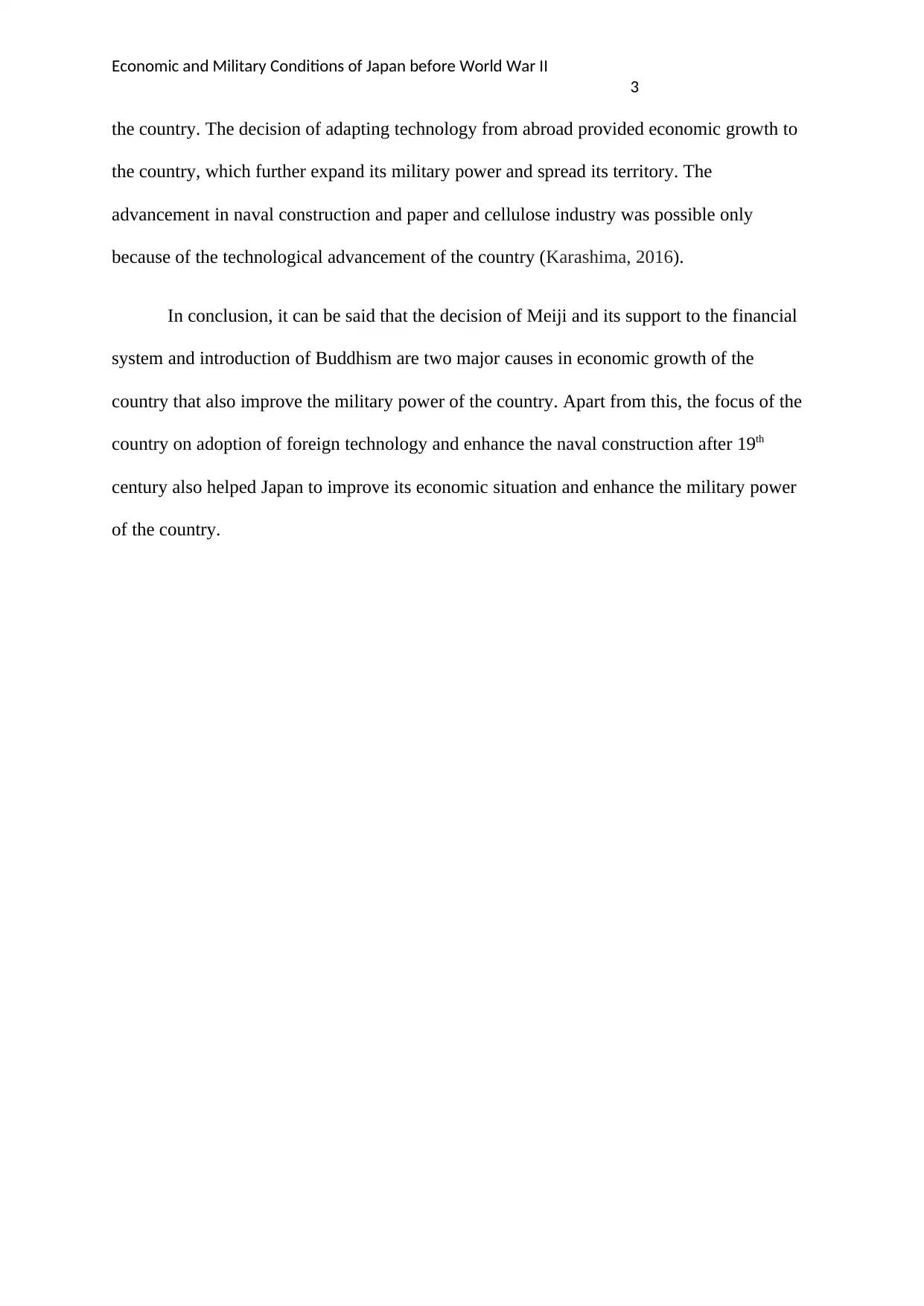
Economic and Military Conditions of Japan before World War II
3
the country. The decision of adapting technology from abroad provided economic growth to
the country, which further expand its military power and spread its territory. The
advancement in naval construction and paper and cellulose industry was possible only
because of the technological advancement of the country (Karashima, 2016).
In conclusion, it can be said that the decision of Meiji and its support to the financial
system and introduction of Buddhism are two major causes in economic growth of the
country that also improve the military power of the country. Apart from this, the focus of the
country on adoption of foreign technology and enhance the naval construction after 19th
century also helped Japan to improve its economic situation and enhance the military power
of the country.
3
the country. The decision of adapting technology from abroad provided economic growth to
the country, which further expand its military power and spread its territory. The
advancement in naval construction and paper and cellulose industry was possible only
because of the technological advancement of the country (Karashima, 2016).
In conclusion, it can be said that the decision of Meiji and its support to the financial
system and introduction of Buddhism are two major causes in economic growth of the
country that also improve the military power of the country. Apart from this, the focus of the
country on adoption of foreign technology and enhance the naval construction after 19th
century also helped Japan to improve its economic situation and enhance the military power
of the country.
Paraphrase This Document
Need a fresh take? Get an instant paraphrase of this document with our AI Paraphraser
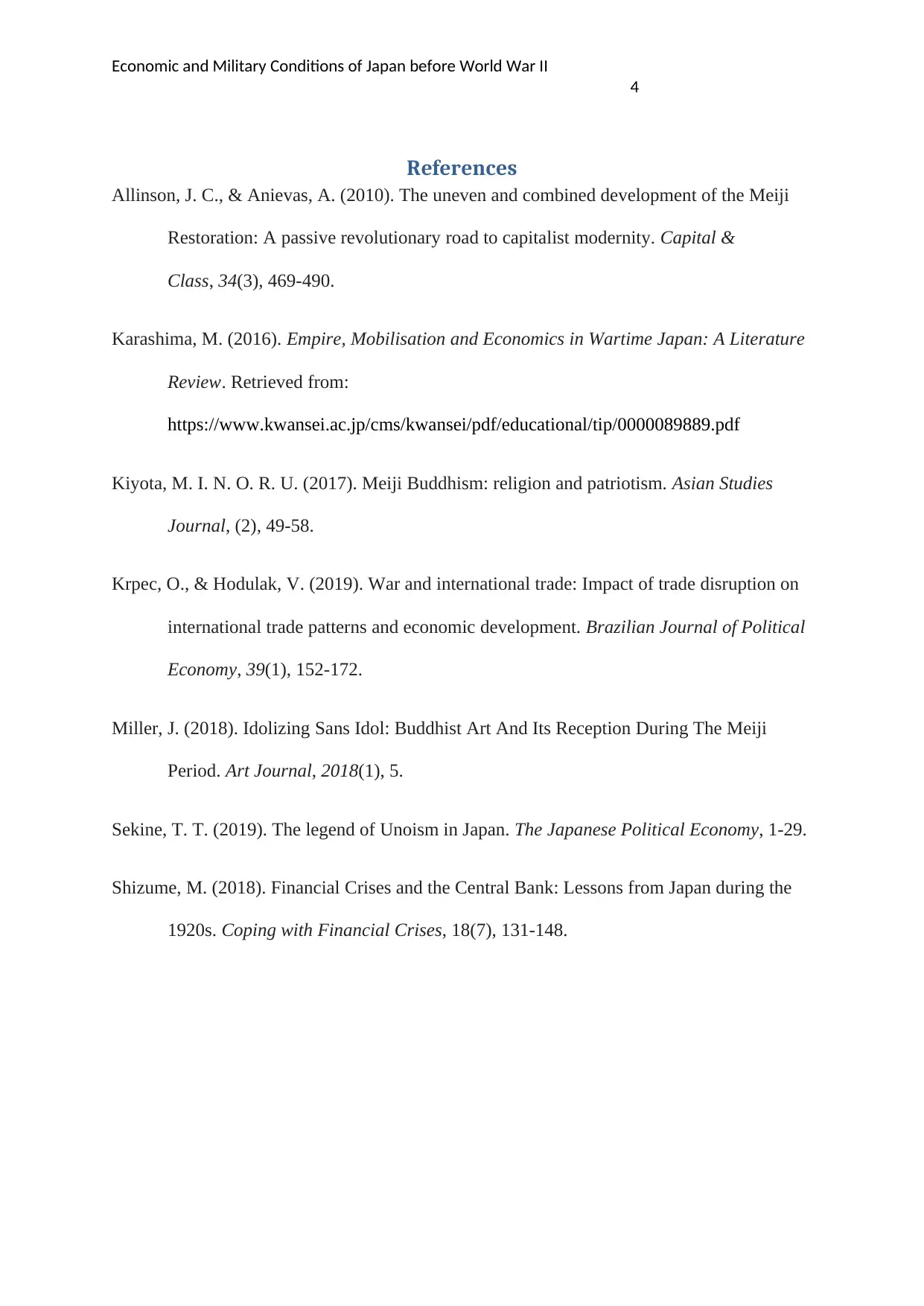
Economic and Military Conditions of Japan before World War II
4
References
Allinson, J. C., & Anievas, A. (2010). The uneven and combined development of the Meiji
Restoration: A passive revolutionary road to capitalist modernity. Capital &
Class, 34(3), 469-490.
Karashima, M. (2016). Empire, Mobilisation and Economics in Wartime Japan: A Literature
Review. Retrieved from:
https://www.kwansei.ac.jp/cms/kwansei/pdf/educational/tip/0000089889.pdf
Kiyota, M. I. N. O. R. U. (2017). Meiji Buddhism: religion and patriotism. Asian Studies
Journal, (2), 49-58.
Krpec, O., & Hodulak, V. (2019). War and international trade: Impact of trade disruption on
international trade patterns and economic development. Brazilian Journal of Political
Economy, 39(1), 152-172.
Miller, J. (2018). Idolizing Sans Idol: Buddhist Art And Its Reception During The Meiji
Period. Art Journal, 2018(1), 5.
Sekine, T. T. (2019). The legend of Unoism in Japan. The Japanese Political Economy, 1-29.
Shizume, M. (2018). Financial Crises and the Central Bank: Lessons from Japan during the
1920s. Coping with Financial Crises, 18(7), 131-148.
4
References
Allinson, J. C., & Anievas, A. (2010). The uneven and combined development of the Meiji
Restoration: A passive revolutionary road to capitalist modernity. Capital &
Class, 34(3), 469-490.
Karashima, M. (2016). Empire, Mobilisation and Economics in Wartime Japan: A Literature
Review. Retrieved from:
https://www.kwansei.ac.jp/cms/kwansei/pdf/educational/tip/0000089889.pdf
Kiyota, M. I. N. O. R. U. (2017). Meiji Buddhism: religion and patriotism. Asian Studies
Journal, (2), 49-58.
Krpec, O., & Hodulak, V. (2019). War and international trade: Impact of trade disruption on
international trade patterns and economic development. Brazilian Journal of Political
Economy, 39(1), 152-172.
Miller, J. (2018). Idolizing Sans Idol: Buddhist Art And Its Reception During The Meiji
Period. Art Journal, 2018(1), 5.
Sekine, T. T. (2019). The legend of Unoism in Japan. The Japanese Political Economy, 1-29.
Shizume, M. (2018). Financial Crises and the Central Bank: Lessons from Japan during the
1920s. Coping with Financial Crises, 18(7), 131-148.
1 out of 5
Related Documents
Your All-in-One AI-Powered Toolkit for Academic Success.
+13062052269
info@desklib.com
Available 24*7 on WhatsApp / Email
![[object Object]](/_next/static/media/star-bottom.7253800d.svg)
Unlock your academic potential
Copyright © 2020–2025 A2Z Services. All Rights Reserved. Developed and managed by ZUCOL.





